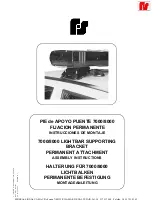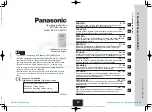
LR7009
Electronic level sensor
10
•
Hysteresis function / normally closed (Fig. Window function): [OUx] = [Hnc].
First the switch point (SPx) is set, then the switch-off point (rPx) with the requested difference.
•
Window function / normally open (Fig. Hysteresis function): [OUx] = [Fno].
•
Window function / normally closed (Fig. Window function): [OUx] = [Fnc].
The width of the window can be set by means of the difference between FHx and FLx.
FHx = upper value, FLx = lower value.
SP
rP
Fig. 3: Hysteresis function
L:
level
HY:
hysteresis
FE:
window
t
L
FH
FL
1
0
1
0
FE
Fno
Fnc
Fig. 4: Window function
L:
level
HY:
hysteresis
FE:
window
For each switching output, a switch-off delay of max. 60 s can be set (e.g. for especially long pump
cycles).
4.4 Offset for indicating the real level in the tank
The zone between tank bottom and lower edge of the probe can be entered as offset value [OFS]. So
display and switch points refer to the actual level.
4.5 Probes for different tank heights
The device can be installed in tanks of different sizes. Probes in different lengths are available. To
adapt to the tank height, each probe can be shortened. The minimum probe length is 10 cm, the
maximum probe length is 160 cm.
Probe and housing can be rotated without restriction. This enables easy installation and orientation of
the head of the device after installation.
4.6 Safe state
For each output, a safe state in the event of a fault can be defined.
If a fault is detected or if the signal quality is below a minimum value, the outputs pass into the "safe
state". For this case the response of the outputs can be set via the parameters [FOU1], [FOU2].
Temporary loss of signal caused e.g. by turbulence or foam formation can be suppressed by a delay
time [dFo].
During the delay time the last measured value is frozen. If the measured signal is received again in
sufficient strength within the delay time, the device continues to work in normal operation. If, however,
it is not received again in sufficient strength within the delay time, the outputs pass into the safe state.
In case of heavy foam build-up and turbulence:
u
Note the examples of how to create a steady area.











































